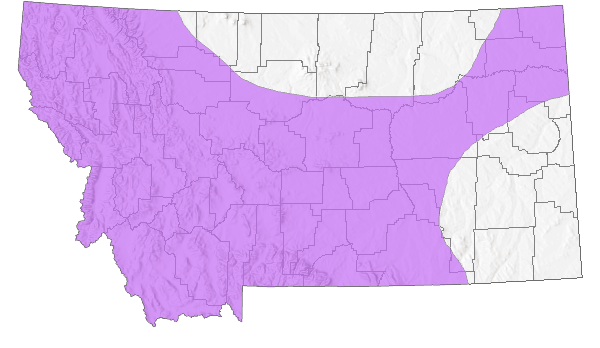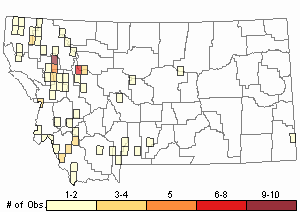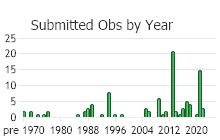View in other NatureServe Network Field Guides
NatureServe
Montana
Utah
Wyoming
Idaho
Wisconsin
British Columbia
South Carolina
Yukon
California
New York
Marsh Horsetail - Equisetum palustre
State Rank Reason (see State Rank above)
Equisetum palustre is known from a small number of sites in eight counties of western and central Montana. Plant observations from Beaverhead, Granite, Lewis & Clark, and Chouteau counties need to be confirmed with specimens.
- Details on Status Ranking and Review
Range Extent
ScoreF - 20,000-200,000 sq km (~8,000-80,000 sq mi)
Area of Occupancy
ScoreD - 6-25 4-km2 grid cells
Number of Populations
ScoreB - 6 - 20
Number of Occurrences or Percent Area with Good Viability / Ecological Integrity
ScoreC - Few (4-12) occurrences with excellent or good viability or ecological integrity
Environmental Specificity
ScoreB - Narrow. Specialist or community with key requirements common
Long-term Trend
ScoreU - Unknown
Trends
ScoreU - Unknown
Threats
ScoreU - Unknown
CommentThreats: Unknown/undetermined.
Intrinsic Vulnerability
ScoreC - Not intrinsically vulnerable
General Description
Plants: Rhizomatous perennials; stems annual, fertile and sterile stems similar, 5–80 cm tall, (Lesica 2012) or up to 1 m or more (McGregor et al. 1986), 1-4 mm in diameter, nearly solid with 4 to 10 ridges (Lesica 2012), branched or unbranched (FNA 1993); central cavity of stem <1/3 the stem diameter (Lesica 2012) and similar in size to the canals under the stem valleys (FNA 1993).
Branches: Usually simple (McGregor et al. 1986), whorled from nodes on upper half (Lesica 2012), spreading, hollow, with 4-6 ridges and rounded valleys; sheaths 5-10 mm (Hitchcock et al. 1969) by 2-5 mm; sheath teeth 5-10 in number, narrow and membranaceous (FNA 1993), persistent, acuminate (McGregor et al. 1986), 3-7 mm tall (Hitchcock et al. 1969), dark with hyaline margins (Lesica 2012); ridges with transverse crests of silicate tubercles (McGregor et al. 1986); first internode length of every branch shorter than that of the stem sheath subtending it (FNA 1993).
(
Lesica et al. 2012. Manual of Montana Vascular Plants. BRIT Press. Fort Worth, TX)
Phenology
Cones mature in summer (FNA 1993).
Species Range
Montana Range
Range Descriptions

 Native
Native
Range Comments
Circumboreal, its southern extent from OR e to MN, WI, PA (Lesica 2012), and NY, Eurasia to the Himalayas, n China, Japan and Korea (FNA 1993).
(Lesica's contribution adapted from Lesica et al. 2012. Manual of Montana Vascular Plants. BRIT Press. Fort Worth, TX)
Observations in Montana Natural Heritage Program Database
Number of Observations: 101
(Click on the following maps and charts to see full sized version)
Map Help and Descriptions
Relative Density

Recency



 (Observations spanning multiple months or years are excluded from time charts)
(Observations spanning multiple months or years are excluded from time charts)
Habitat
Wet soil and shallow water, often in forests; valleys to montane, occasionally subalpine (
Lesica et al. 2012. Manual of Montana Vascular Plants. BRIT Press. Fort Worth, TX).
Reproductive Characteristics
Strobili: Borne on a peduncle (McGregor et al. 1986), 5–15 mm (Lesica 2012) or as long as 25 mm long (McGregor et al. 1986), deciduous, the apex blunt (Hitchcock et al. 1969).
(Lesica’s contribution adapted from
Lesica et al. 2012. Manual of Montana Vascular Plants. BRIT Press. Fort Worth, TX)
Stewardship Responsibility
Threats or Limiting Factors
STATE THREAT SCORE REASON
Threat impact not assigned because threats are not known (MTNHP Threat Assessment 2021).
References
- Literature Cited AboveLegend:
 View Online Publication
View Online Publication Britton, N. L. and A. B. Brown. 1913. An Illustrated Flora of the Northern United States, Canada, and the British Possessions. 2nd Edition in 3 Volumes. New York, NY: Charles Scribner's Sons. B13BRI01PAUS.
Britton, N. L. and A. B. Brown. 1913. An Illustrated Flora of the Northern United States, Canada, and the British Possessions. 2nd Edition in 3 Volumes. New York, NY: Charles Scribner's Sons. B13BRI01PAUS. Flora of North America Editorial Committee, eds. 1993. Flora of North America North of Mexico. Volume 2. Pteridophytes and Gymnosperms. Oxford University Press, Inc., NY. xvi + 475 pp.
Flora of North America Editorial Committee, eds. 1993. Flora of North America North of Mexico. Volume 2. Pteridophytes and Gymnosperms. Oxford University Press, Inc., NY. xvi + 475 pp. Hitchcock, C. L., A. Cronquist, M. Ownbey, and J. W. Thompson. 1969. Vascular Plants of the Pacific Northwest. Part I: Vascular Cryptogams, Gymnosperms and Monocotyledons. Seattle, WA: University of Washington Press. 914 pp.
Hitchcock, C. L., A. Cronquist, M. Ownbey, and J. W. Thompson. 1969. Vascular Plants of the Pacific Northwest. Part I: Vascular Cryptogams, Gymnosperms and Monocotyledons. Seattle, WA: University of Washington Press. 914 pp. Lesica, P., M.T. Lavin, and P.F. Stickney. 2012. Manual of Montana Vascular Plants. Fort Worth, TX: BRIT Press. viii + 771 p.
Lesica, P., M.T. Lavin, and P.F. Stickney. 2012. Manual of Montana Vascular Plants. Fort Worth, TX: BRIT Press. viii + 771 p. McGregor, R.L. (coordinator), T.M. Barkley, R.E. Brooks, and E.K. Schofield (eds). 1986. Flora of the Great Plains: Great Plains Flora Association. Lawrence, KS: Univ. Press Kansas. 1392 pp.
McGregor, R.L. (coordinator), T.M. Barkley, R.E. Brooks, and E.K. Schofield (eds). 1986. Flora of the Great Plains: Great Plains Flora Association. Lawrence, KS: Univ. Press Kansas. 1392 pp. MTNHP Threat Assessment. 2021. State Threat Score Assignment and Assessment of Reported Threats from 2006 to 2021 for State-listed Vascular Plants. Botany Program, Montana Natural Heritage Program, Helena, Montana.
MTNHP Threat Assessment. 2021. State Threat Score Assignment and Assessment of Reported Threats from 2006 to 2021 for State-listed Vascular Plants. Botany Program, Montana Natural Heritage Program, Helena, Montana.
- Additional ReferencesLegend:
 View Online Publication
View Online Publication
Do you know of a citation we're missing? Culver, D.R. 1994. Floristic analysis of the Centennial Region, Montana. M.Sc. Thesis. Montana State University, Bozeman. 199 pp.
Culver, D.R. 1994. Floristic analysis of the Centennial Region, Montana. M.Sc. Thesis. Montana State University, Bozeman. 199 pp. Lesica, P., M.T. Lavin, and P.F. Stickney. 2022. Manual of Montana Vascular Plants, Second Edition. Fort Worth, TX: BRIT Press. viii + 779 p.
Lesica, P., M.T. Lavin, and P.F. Stickney. 2022. Manual of Montana Vascular Plants, Second Edition. Fort Worth, TX: BRIT Press. viii + 779 p.
- Web Search Engines for Articles on "Marsh Horsetail"





